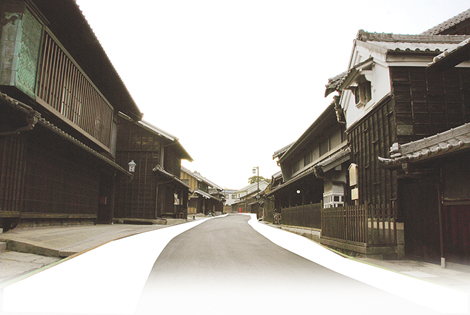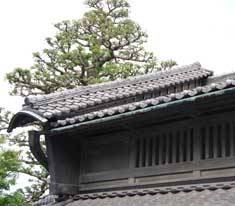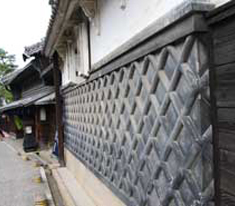




有松は、慶長13年(1608年)尾張藩によってあらたに作られた茶屋集落です。これよりさき慶長5年(1600年)の関ヶ原の合戦以降は、天下の政権が徳川氏の手に帰し、江戸が幕府の所在地ととなりました。これにともなって、徳川幕府は江戸と各地を結ぶ交通整備のため、「伝馬制度」が慶長6年(1601年)新たに定められました。
東海道では鳴海宿と池鯉鮒宿など53宿が設けられ、あらたな東海道が生まれました。尾張藩は、藩内の宿場の制度を整えて、東海道の修築につとめていましたが、鳴海宿以東一帯は丘陵の起伏している間に松林が生い茂り、人家も耕地もなく、街道はきわめてさびしい状態でした。ときどき盗賊の類が出没し、旅人に危害を加えることさえありました。そこで、この附近に新しく部落を設ける必要を感じ、慶長13年(1608年)12月、一種の特典を与えて移住を奨励することになったのです。このときの布告は知多郡全体に発せられたものと思われますが、現在有松町につぎのような写しが伝存しています。
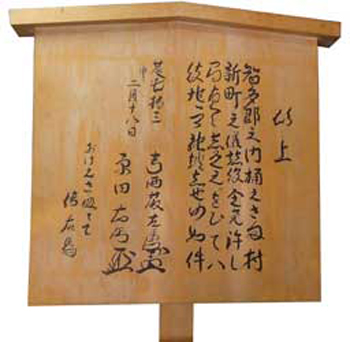
以 上
知多郡之内桶はさま村新町之儀、諸役令免許候間、望之者有之においては、彼地へ可被越者也、仍如件
慶長拾三年 申二月十八日 寺西藤左衛門手判 原田 右衛門手判 おけはざまにて
伝右衛門
作十郎
すなわち、桶狭間新町では、諸役を免除するから、希望者は移住して来るようにとの趣旨である。
この布達に応じて、慶長13年中に移住してきたひとびとは、長五郎・九左衛門・九兵衛・勘次・弥七・庄九郎・新助・治郎作の八名でした。出身地は知多郡の阿久比庄といわれています。
こうして、有松は桶狭間村の一支郷として誕生することになったのです。
なお、有松という名称は、松が生い茂っているところにできた村だからという説と、「新町」(あらまち)が転じて「有松」と呼ばれるようになったとの説があります。
The birth of Arimatsu town
Arimatsu Village was established as a teahouse village by the Owari feudal clan in 1608(Keichou era 13th). After The battle of Sekigahara in 1600(Keichou era 5th ), Japan was under the control of Tokugawa with The Shougunate located in Edo. It was now necessary for a Transport Development system to be created connecting the rest of the country to Edo, so The Tenma Seido (Postal-horse system) was newly introduced. The Tokai-Do Highway was designed with 53 postal stations, including Chiryu Postal town and Narumi Postal town.
The Owari feudal clan endeavored to establish this system of postal towns and renovate the highway. To the east of Narumi Postal town there were no settlements. It was extremely isolated with rolling hills covered in pine forests and infested with bandits who attacked travelers time to time. Therefore, the Owari feudal clan saw the need to establish a village in this area and encouraged individuals, through incentives, to settle this area in 1608(Keicho 13th). A proclamation to this effect was given to all Chita-Gun District villagers and a copy of this can still be found in Arimatsu town. The proclamation states that the Owari feudal clan encourages people to settle in Okehazama shinnmachi(Okehazama new village) and that they will be given various benefits and exemptions for doing this. Following this administrative order, it is said that eight families by the names of Chougoro, Kuzaemon, Kyubei, Kanji, Yahichi, Shokuro, Sinnsuke and Jirosaku moved from Agui, Chita Gun (Chita Distric) to this area.
Then the new village of Arimatsu was born as a branch of Okehazama village.
It should be noted that there were two origins names for Arimatsu , one comes from the meaning “where pines are overgrown”, the other is that the pronunciation of Aramachi(new town) changed to Arimatsu.

![]()
阿久比庄から移住した庄九郎が絞り染めをつくり始めたきっかけは、慶長15年(1610年)名古屋築城のときです。九州豊後国の諸大名が築城工事の手伝いに来ていましたが、豊後のひとたちのなかに絞り染めをもつ者がいました。これを珍しく思って注目した庄九郎が、製法のヒントを得て、その後有松でつくり始めたとのことです。その真偽はともかく、有松の地に移住して来た人たちは、なんらかの副業を営む必要に迫られていました。桶狭間の北端に設けられたこの新村は、松林の生い茂る丘に囲まれて、開発の可能な土地がきわめて少なく、農業ばかりではとうてい生活を維持できない状態であったからです。
有松で最初につくられた絞りは、蜘蛛(くも)絞りといわれるものです。布地をその一部分づつつまんで糸で括り、全幅を絞ったのち、これを幾度も藍がめに投入し染めつけ、乾燥して絞り糸を抜けば、蜘蛛の巣の形をした絞り模様ができます。これが有松絞り製作の起源となったものです。当初は手拭としてつくられ、屋外の竹竿に三筋五筋をつるし、街道通行の旅人に売っている程度でした。
有松絞りが世に知られるようになったのは、寛永18年(1641年)徳川光友(尾州二代藩主)が、世継としてはじめて尾張に入国したとき、光友の有松村通過に当たり、村人が入国祝いに鍛絞りの手綱を献上しましたが、これで「有松絞り」の名が天下に知らされました。こうして、蜘蛛絞りの手拭、鍛絞りの手綱が製作され、後年の有松絞の名声を博する基礎がしだいにかたちづくられていったのです。その後、三浦絞り、大名絞り、杢目絞り、蜘蛛段絞り等の発明があり、絞り染めはいっそう発展したのです。
The birth of the Tie-Dyeing industry
The beginnings of the Tie-Dyeing industry in Arimatsu can be traced to a man name Shoukurou who was one of the eight original settlers from Agui, Chita-gun District
When Nagoya Castle was being constructed in 1610(Keicho era 15th),
a feudal lords from the Bingo region of Kyuushu brought many construction worker to assist with the castle’s construction. Shoukurou noticed some of these workers had hand towels made with tie-dye designs. Attracted to the uniqueness of tie-dyeing, he learned many tie-dying techniques.
Shoukurou started to make his own tie-dyed products at Arimatsu village, located in the northern outskirts of Okehazama village. Since the village was surrounded by hills covered in thick pine forests, the settlers there had little farmland and were having a hard time making a living by relying only on agriculture. They were therefore forced to look for additional means to improve their livelihoods.
The first tie-dye products made in Arimatsu are said to have been Kumosibori(spider tie-dyeing)which makes a pattern in shape of a spider web. This was the origin of Arimatsu tie-dyeing. The way to make Kumosibori is as follows: 1st step; bundle the cloth by evenly pleating in portions of the fabric. Then continue bundling the rest of the fabric in the same manner 2nd step; the cloth is repeatedly put into indigo dye 3rd step; allow the cloth to dry 4th ; unfasten all of the bundles in the cloth
At first, those were created as hand towels and many were sold to travelers by display four or five pieces on a bamboo pole outdoors.
In 1641(Kanei era 18th ), Mitsutomo Tokugawa (appointed the Heir as 2nd feudal lord of Owari Province) came to the province for first time and passed through Arimatsu village. Arimatsu villagers presented Tokugawa with celebratory goods, reins made of tie-dying, as tribute. In this way, Arimatsu tie-dying became known to the world. From this time, hand towels and tie-dyed reins were extensively produced and sold. Gradually the foundation for the fame Arimatsu tie-dying enjoyed in later years was being laid. Later on, a lot of new tie-dying technology was invented, such as Miura (the name of a family), Daimyo (a feudal lord), Mokume (wood grain), Kumodan (spider stage), Arimatsu tie-dyeing was increasingly developed.
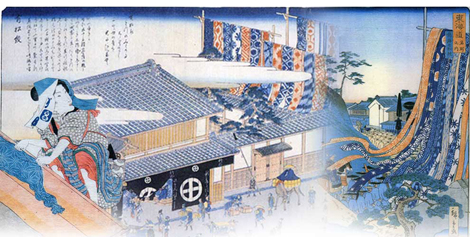
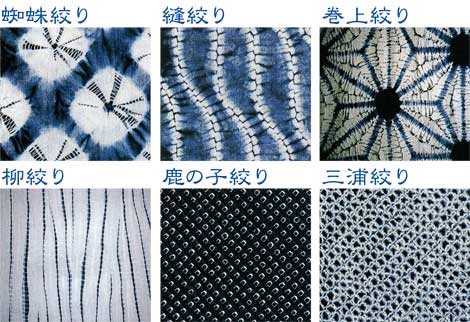
![]()
![]()
絞りによって発展してきた村も天明4年(1784年)大火が起って、全村のほとんどを焼失し、創設以来茅葺の町屋は一朝にして灰燼に帰しました。この大火は併せて絞り染め遺物、古文書を初め、旧い形態を残す工房、蔵などの貴重な資料を一掃しました。元来有松における絞業形態は、手工業からマニュファクチュア(工場制手工業)に移行する過渡的な段階を採っていたと見られるだけに、天明の大火は大いに惜しまれますが、この時も藩の手がさしのべられ、絞問屋は20戸以上は許さないなど保護策が採られ、ほとんど無制限の商業権が与えられたのです。かくて20年後の享和の頃(1800年初)には、町もほとんど復興し、その製品も絹染めの如き元禄年間に優る美事な製品を販出するようになっています。
この天明大火による復興に当たっては、従来の茅葺を瓦葺に改め、構造も塗ごめ造りとし「うだつ」を設け、防火的にする等の用意周到さを見せ、ここに江戸の町屋に比肩される町並みを造り出し、さらに一層の繁栄を示したのでした。
その建屋の多くが現在も残っており、有松の町並みの美しさを表現しています。
The birth of the cityscape
The village had prospered by tie-dyeing, but in 1784 (Tenmei Era 4th ) a catastrophic fire rapidly destroyed most of the houses which were constructed with thatched roofs. All of the valuable documents and important materials such as tie-dyeing relics, ancient documents, old style workshops, and warehouses were lost.
Originally, the tie-dye manufacturing system in Arimatsu village had been progressing from individual handicrafts to a factory style handicraft production system. It was a fairly progressive manufacturing system, so the Owari feudal clan government took action to limit the number of wholesalers, a maximum of twenty only, and put almost unlimited commercial privileges into place to help the village. As a result, in the early days of 1800 (Kyouwa Era) the village successfully recovered and further developed to a level selling excellent, superior silk products above par with Genroku Era’s.
During recovery from the catastrophic fire, the construction standard for houses was strictly controlled. It included having a tiled roof, Nurigome (thick mud-plastered side walls) and Udatsu (a firewall on the roof) for prevention of fire.
Thus, the row of houses in Arimatsu village had created streets that were comparable to Edo Machiya (a type of residence or store or the row of houses in the central part of a town) and helped to create greater prosperity.
Many of Machiya on the streets still exist and help to create the unique and beautiful townscape of Arimatsu.
*Note; The original meaning of Udatsu was a firewall built on the roof of a house. A house owner with a pair of Udatsu was generally considered to be rich and successful. From this mean, the saying developed: To say “I put up a Udatsu” means “I have become rich and successful”
